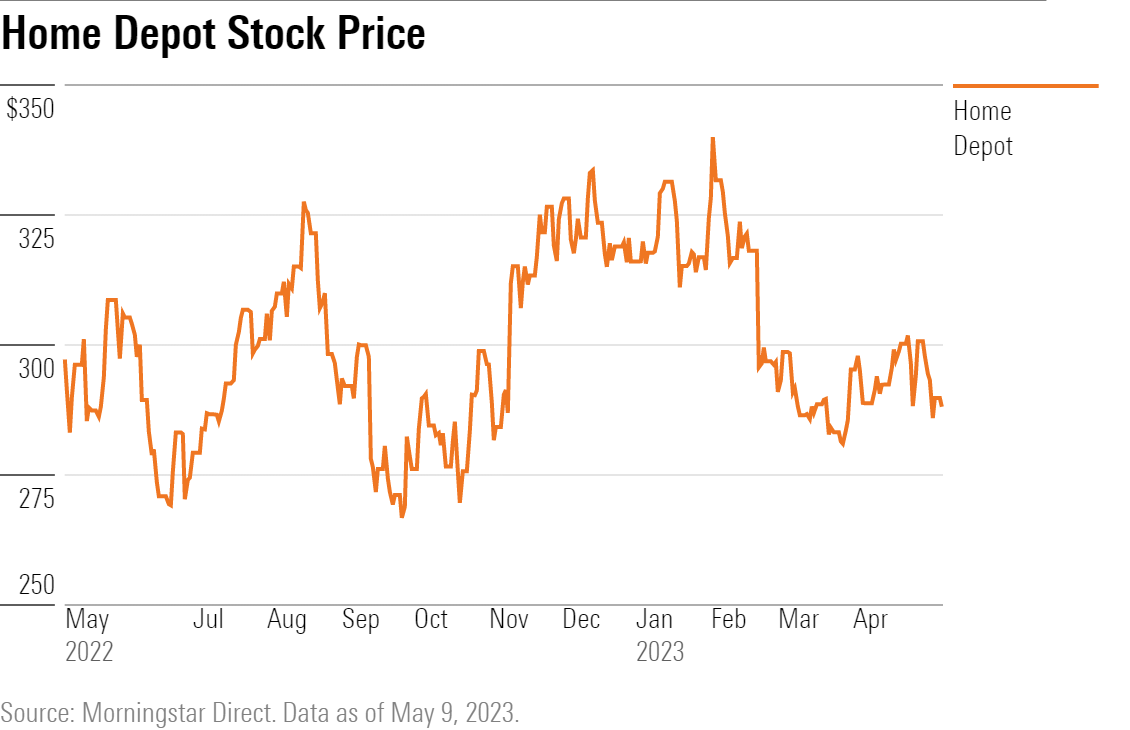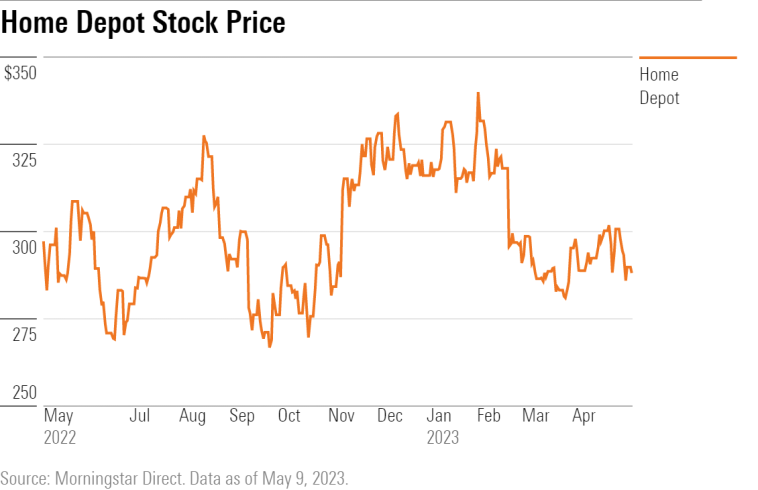
Assessing Home Depot’s Stock Resilience amid Lower Interest Rates
The current economic climate presents investors with a mix of opportunities and setbacks. In many ways, the error message “Access Denied” we once encountered symbolizes today’s market restrictions—where certain investment avenues seem locked away, yet those with the right insight find paths forward. Amid a challenging quarter and a myriad of twisted issues in global finance, Home Depot stands out as a strong play in a landscape defined by lower interest rates.
Over the past few quarters, investors have grappled with tricky parts of the market. With lower rates prompting a re-evaluation of growth prospects, many see Home Depot as a resilient option even when performance numbers appear intimidating at first glance. In this editorial, we aim to take a closer look at why this home improvement giant continues to attract buyer attention despite short-term setbacks and evolving economic conditions.
Home Depot’s Strong Market Position in a Low-Rate Environment
It might seem counterintuitive that a company facing a rough quarter can emerge as the best stock play when rates are lower. However, lower rates often result in cheaper borrowing costs for both companies and consumers. Home Depot is uniquely positioned to benefit from this dual-edged scenario. In many ways, the current trend underscores that opportunities often hide in the fine shades of underperformance, especially when the bigger picture shows promise.
At first glance, a tough quarter might appear nerve-racking for investors who worry about short-term fluctuations. Nevertheless, industry veterans argue that the current weak performance signals temporary hurdles rather than long-term decline. Home Depot’s long-standing business model, combined with its capacity for innovation in customer experience and operational efficiency, allows it to tackle confusing bits and twists and turns head-on.
- Lower borrowing costs stimulate consumer spending on home improvement projects.
- Efficient supply chain management helps mitigate the impact of global market disruptions.
- Strategic expansion and remodeling initiatives promise competitive advantages over peers.
Thus, even though the recent financial report may have been off-putting for some, the underlying fundamentals of Home Depot remain robust. Investors who figure a path through short-term setbacks are likely to find a sturdy company ready to capitalize on an environment where lower rates are a key benefit.
Economic Trends Influencing Investment Strategies in Challenging Quarters
When discussing the market conditions that affect stock performance, it is essential to consider the broader economic trends. Lower interest rates are more than just a tool for controlling inflation; they directly influence consumer behavior and investor sentiment. In times characterized by tangled issues and intimidating market signals, companies that can weather these headwinds with stability are often seen as a safe haven.
Investors considering Home Depot should not only look at quarterly earnings but also at macroeconomic trends such as:
- Consumer confidence indexes that drive spending on renovations.
- Inflation trends and how they influence home improvement costs.
- Government policies and business tax laws that could shape operational costs.
For instance, when rates drop, borrowing becomes less expensive for both accumulation-minded investors and risk-averse ones. Home Depot can use its improved access to capital for strategic initiatives, such as expanding product lines or venturing into uncharted markets, thus turning a seemingly challenging quarter into a stepping stone for future growth.
In essence, aligning short-term observations with long-term economic trends allows investors to dig into the subtle parts of market dynamics. While the quarterly performance may be loaded with issues, the overarching trend points to a promising opportunity for a company that effectively steers through economic downturns.
Small Business Dynamics: Opportunities and Challenges Amid Lower Borrowing Costs
The market landscape for small business owners is as dynamic as it is full of problems. Many small businesses, particularly those in construction, automotive, and industrial manufacturing, rely on a steady demand for home improvement products. Here, Home Depot’s performance can have a considerable ripple effect, indirectly influencing the stability of these smaller enterprises.
Lower interest rates also make it easier for small businesses to secure loans, thus opening avenues for expansion and the adoption of new technologies. However, navigating these opportunities requires a keen understanding of the fine points of financial management, and a solid strategy to avoid falling prey to the nerve-racking twists and turns of the market.
Some key aspects small businesses should consider include:
- The impact of lower borrowing costs on cash flow management.
- Using strategic partnerships with larger firms like Home Depot to boost supply chains.
- Monitoring market trends to capitalize on periods of economic growth while preparing for slower phases.
For small businesses, the current conditions are a double-edged sword—with challenges on one side and opportunities on the other. The same factors contributing to Home Depot’s appeal as a stock can also serve as a launchpad for broader business growth, provided that owners are ready to tackle the confusing bits and small distinctions of market dynamics.
Industrial Manufacturing’s Role in Reinforcing Retail Stocks
Industrial manufacturing is an unsung hero in the narrative of retail stock resilience. The production line behind Home Depot’s extensive range of products involves a robust industrial ecosystem that faces its own set of twisted issues and challenging regulatory environments. Nonetheless, this system’s ability to adapt and overcome temporary setbacks adds an extra layer of strength to the overall business model.
One of the significant benefits of lower interest rates is the enhanced capacity for industrial manufacturers to invest in new technology. Such improvements not only streamline production processes but also lower shipping and logistics costs. This, in turn, ensures that companies like Home Depot can maintain reasonable price points and stable supply chains even when economic conditions are full of problems or intimidating.
A quick overview of the advantages includes:
| Advantage | Benefit to Home Depot |
|---|---|
| Lower production costs | Improved profit margins |
| Technological upgrades | Enhanced operational efficiency |
| Stable supplier networks | Reliable inventory management |
By integrating improvements from industrial manufacturing, Home Depot not only reduces the immediate challenges tied to a tough quarter but also lays the groundwork for steady future growth. Investors looking to make sense of market dynamics would do well to consider how each link in the chain—be it manufacturing or retail—contributes to a resilient overall business model.
How Automotive and Electric Vehicle Trends Affect Retail Retailers
Often, the spotlight in investment discussions lands on core industries like retail and manufacturing; however, the automotive sector, including the booming market for electric vehicles, also plays a significant role in shaping the retail environment. At first, the connection might seem off-putting, yet a closer analysis reveals a network of influences that these sectors have on consumer spending and overall economic momentum.
For example, lower interest rates tend to benefit automotive consumers, making financing more affordable. As people spend more on vehicles, they also tend to invest in home improvements, which can drive up demand for Home Depot’s products. Meanwhile, the increased focus on sustainability and energy efficiency in the automotive sector translates into higher investments in related retail segments, such as eco-friendly building materials and advanced energy solutions.
Key considerations in this context include:
- The correlation between automotive financing and consumer credit behavior.
- The rising demand for energy-efficient home solutions influenced by electric vehicle popularity.
- The broader trend of sustainability and its impact on retail product lines.
With the automotive landscape in flux due to technological advancements and evolving consumer preferences, retailers like Home Depot stand to gain from these shifts. The confluence of lower interest rates and a burgeoning electric vehicle market creates an environment where spending in one sector directly supports growth in another, turning what might seem like a nerve-racking shift into a super important catalyst for positive change.
Understanding Business Tax Laws Influencing Investment Decisions
Business tax laws are among the trickier parts of the investment landscape, laden with tangled issues and subtle details that can deeply affect a company’s bottom line. For Home Depot, careful management of tax liabilities and compliance with evolving regulations is not merely a matter of following rules but a strategic element of its business model.
Recent changes in tax policy have led to a wave of re-assessments in various industries. When rates are lower, companies often leverage tax incentives to invest in growth initiatives and technology upgrades. For Home Depot, these must-have incentives help counterbalance the overwhelming aspects of a rough quarter.
A snapshot of the key impacts of business tax laws includes:
- Tax credits for energy-efficient installations that align with consumer demand for green products.
- Accelerated depreciation on capital investments, allowing for quicker returns on new technologies.
- Incentives for domestic production that bolster industrial manufacturing sectors.
For investors, understanding the influence of tax policy changes is as crucial as analyzing quarterly earnings. The company’s ability to work through these subtle details and leverage the latest tax laws can make it a compelling option, even when its short-term performance might appear loaded with issues. It is essential to examine not only what investors see in the balance sheet today but what strategic advantages a company holds due to effective tax management.
Market Indicators and the Future of Investment in Home Improvement Retail
In the face of a challenging quarter, several market indicators suggest that Home Depot’s ability to maintain its position in a low-rate environment is not in doubt. Investors keeping an eye on evolving economic trends might notice several factors that indicate a turning point rather than a setback. These include:
- Steady consumer demand for home renovations across diverse geographical regions.
- Innovative use of technology for both customer engagement and supply management.
- Resilient performance in sectors indirectly influenced by government policies and lower rates.
When one takes a closer look, these points suggest that the current rough patches should be viewed as temporary delays rather than indicators of systemic failure. In many cases, companies that successfully manage their way through intimidating market dynamics are the ones that truly shine in the long term.
Investors would do well to consider a few vital market indicators, such as:
| Indicator | Implication for Home Depot |
|---|---|
| Consumer Spending Trends | Predicts demand for home renovation supplies |
| Interest Rate Adjustments | Impacts cost of capital and borrowing |
| Supply Chain Resilience | Ensures consistent product availability |
For those sorting out their investment strategies, keeping a close eye on these subtle indicators can help demystify some of the seemingly complicated pieces of current market behavior, reinforcing the case for Home Depot as a compelling stock choice.
Strategies for Investors Amid Challenging Economic Phases
From an investor’s standpoint, understanding how to tackle the challenging segments of an economic cycle is akin to managing through a maze of tangled issues. It is not enough to simply analyze quarterly figures; one must also consider the off-putting twists and the fine shades present in the overall market environment. In this context, a strategy that emphasizes long-term gains over short-term setbacks can be the difference between success and disappointment.
For those planning their next moves in the stock market, particularly in sectors impacted by lower interest rates, the following strategies can prove useful:
- Diversification: Spread investments across various sectors to minimize risk. In this case, blending stocks in retail, industrial manufacturing, and even emerging markets like electric vehicles creates a balanced portfolio.
- Long-Term Vision: Focus on companies with robust business models that perform well over the long haul, even if a tough quarter surfaces amid confusing bits and nerve-racking market turns.
- Monitoring Economic Indicators: Regularly review consumer and industrial trends that correlate with lower interest rates to identify opportunities early.
- Adapting to Policy Changes: Stay in tune with updates in business tax laws and other regulatory changes that could tilt the scales in favor of certain companies.
By following these steps, investors can get around the immediate hurdles and ultimately benefit from the robust fundamentals that promising firms like Home Depot have demonstrated over time. The focus should always be not just on surviving the current tough quarter but on crafting a resilient strategy that can withstand future market twists and turns.
Taking a Closer Look at Home Depot’s Growth Prospects and Investment Value
As we poke around the numbers and market sentiment, what stands out about Home Depot is its consistent ability to generate growth in an environment riddled with tension. Despite reports of a challenging quarter, the company’s measures to optimize its operations and improve customer engagement remain super important factors in maintaining its long-term investment value.
Some of the elements that contribute to Home Depot’s potential growth include:
- Robust Expansion Strategies: The company continuously refines its store formats and online presence, paving the way for increased market penetration even in difficult economic conditions.
- Technological Innovations: Investments in digital platforms and supply chain technology help streamline operations, reduce delays, and ultimately result in better customer satisfaction.
- Customer Loyalty Programs: Programs designed to keep returning customers have proven effective at generating steady revenues, which is a key factor for investors watching quarterly figures.
By focusing on these factors, Home Depot not only strengthens its market position but also offers reassurance to investors that short-term setbacks are part of a larger strategy geared toward sustainable growth. This approach is a prime illustration of a company that is finding its way through complex market signals to deliver long-term shareholder value.
Long-Term Economic Outlook and the Role of Home Improvement Retail
The future of retail, especially in the home improvement sector, is closely tied to broader economic trends and technological advancements. Even when faced with a quarter that appears intimidating, companies like Home Depot remain super important as economic stabilizers and growth drivers. Their ability to adjust to market shifts—ranging from lower interest rates to evolving consumer purchasing patterns—illustrates how a well-managed retailer can thrive even in times of economic uncertainty.
Looking ahead, several factors will likely contribute to the resilience and evolution of the home improvement retail sector:
- Rising Home Renovation Trends: As more people invest in upgrading their living spaces, the demand for home improvement products is expected to grow steadily.
- Shifts in Consumer Behavior: With access to financing becoming easier through lower rates, more consumers are expected to make significant home improvement purchases.
- Technological Integration: Digital tools that enhance both the in-store and online shopping experiences will continue to be a differentiator for leading retailers.
- Economic Recovery Measures: Government initiatives aimed at stimulating the economy, including infrastructure developments and targeted tax credits, will likely support increased consumer and industrial spending.
Investors need to realize that while navigating these twisting issues may be off-putting in the short term, the long-term outlook remains promising. The evolution of consumer habits, bolstered by favorable financing conditions and strategic corporate planning, reinforces that Home Depot is well-prepared for future success.
Conclusion: Embracing Resilience in a Changing Economic Landscape
In today’s complex economic environment, the financial hurdles and nerve-racking twists that companies face are part of a broader narrative. Home Depot’s recent challenging quarter, while initially off-putting, provides an opportunity for investors to look beyond immediate setbacks and appreciate the underlying strengths of a company that is both adaptable and forward-thinking.
From the benefits of lower interest rates and improved industrial efficiency to the ripple effects in small business sectors and even the automotive market, multiple factors come together to create a scenario where Home Depot shines as a solid investment choice. It is a firm that not only finds its way through challenging market dynamics but also lays the groundwork for long-term resilience through strategic investment in technology, customer engagement, and operational excellence.
For investors who are keen on working through economic uncertainties, the key lies in focusing on companies that can steer through the confusing bits of short-term performance while preparing for expensive rewards in the future. Home Depot’s ability to manage its way through taxing market conditions, leverage beneficial business tax laws, and align with overall economic trends makes it a compelling choice in today’s financial landscape.
Ultimately, embracing opportunities in a low-rate environment involves looking at the bigger picture. While some quarters are undeniably full of problems, they offer a chance to understand the subtle details that drive long-term success. By making informed decisions based on diversified strategies and careful analysis of market indicators, investors can find value, even amidst a challenging quarter.
As the market continues to evolve, the combination of resilient business practices and the strategic use of lower borrowing costs provides a clear path forward. Home Depot, with its strong fundamentals and innovative spirit, is positioned to continue delivering steady growth, making it a noteworthy candidate for those looking to secure value in turbulent times.
This analysis serves as a reminder that while error messages and access denials may occasionally block immediate insights, a deeper investigation into the market trends reveals opportunities that are worth the extra effort. Investors who are willing to take a closer look, sift through the nitty-gritty details, and get into the underlying factors at play, will often uncover value that many others may miss.
In summary, the remarkable interplay between lower interest rates, consumer behavior, technological advancement, and robust operational strategies makes Home Depot more than just a stock choice—it becomes a case study in resilience and strategic growth amid a constantly shifting economic backdrop. Whether you are an experienced investor or a small business owner seeking guidance during challenging periods, remember that sometimes the best opportunities are hidden within temporary setbacks, waiting to be discovered by those who are diligent enough to figure a path through the market’s tangled issues.
Originally Post From https://www.cnbc.com/2025/11/18/despite-tough-quarter-home-depot-is-the-best-stock-play-on-lower-rates.html
Read more about this topic at
Access Denied on several sites? : r/techsupport
Access denied to basic websites – Microsoft Q&A

